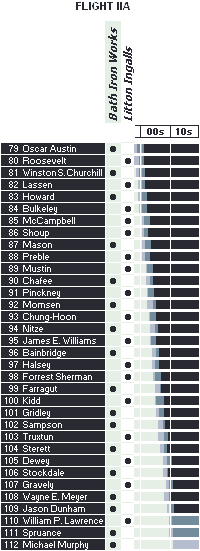

Lead ship for Flight IIA was Oscar Austin, laid down in 1997 and the first destroyer commissioned in 2000. Her main recognition feature was an enclosure for side-by-side helecopter hangars aft; her flight deck was also enlarged. Systems enhancements included organic minehunting and area theater ballistic missile defense.
Length: 510 feet overall; 471 feet LWL.
Displacement: 6,600 long tons light; 9,157 long tons full load.
Helicopters: 2 SH-60B/F LAMPS.
Other: See Flight I.
Other alterations followed. Winston S. Churchill, commissioned in 2001, was first to mount a new 5-inch/62 caliber gun. McCampbell and several following ships initially deleted the CIWS in favor of the (NATO) Evolved Sea Sparrow missile. Mustin introduced a funnel that deleted the visible caps, further reducing her radar signature.
Flight IIA originally included 34 ships—more than half the Arleigh Burkes—with construction equally divided between Bath Iron Works and Northrup Grumman’s Huntington Ingalls Industries Inc. at Pascagoula, Mississippi.
Construction of Ingalls’ next ship, Truxtun, was delayed by a fire on 20 May 2006. She christened just over two years after her keel was laid.
In early 2012, names were given to four ships (DDG 113–116). As presently planned, 13 ships (through DDG 125) will be funded through fiscal year 2017. Huntington Ingalls (the former Northrop Grummann) at Pascagoula, Mississippi has taken over from Bath Iron Works as the lead yard.